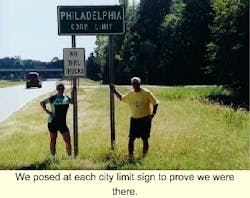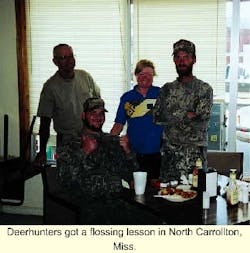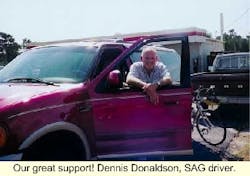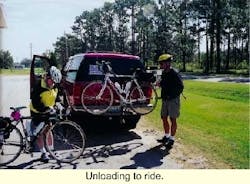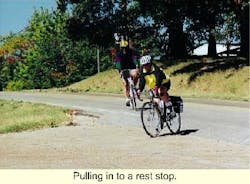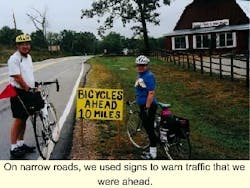Flossing to Florida: Remembering the great bicycle ride
Many grand ideas are born over noontime staff meetings. This one was no different. In September 1999, a doctor in our building asked me to have lunch with him. I thought it was probably to ask me to work a day for him. The big question came over pasta: "Do you think you could ride your bike to Florida?" What a question to ask a hygienist! After all, we meet challenges every day at work with patients and office dynamics, as well as juggling work and family in our personal lives. So this challenging question didn't scare me one bit.
I had recently started riding my bicycle again after five years of no exercise and finding myself getting heavier and my energy level continuously falling. I had once been quite the cyclist, and everyone in the office knew I was setting goals to ride longer distances again. The challenge of riding to Florida was the perfect gateway for me. My answer, without a pause, was, "Yes!" And with the challenge made, the planning began.
Dr. John Craig was nearly 60. He didn't even own a bicycle, but he wanted to ride to Florida to prove to himself and probably to everyone he knew that he could do it. He knew my reputation for meeting challenges and knew I would not turn down the chance to prove myself as well. After all, I was nearing 50 and wanted to know that I still could meet a challenge too.
The equipment
Riding cross-country on bicycles requires more than a bike from a discount store. The bike I was currently riding was a good one, but nearly 15 years old. So shopping for a good bicycle was the first order of business. We both carefully chose bikes that would be lightweight and efficient to ride. I chose a Bianchi Volpe and John chose a Redline.
Gearing is very important. Our bikes have 27 gears, allowing for multiple speeds, so climbing hills becomes less of a challenge. The shift levers are indexed (shift one gear at a time) and on the handlebar grips, so you never have to change your hand position to shift. The pedals are small and our special shoes snap to them, making each pedal stroke more efficient by allowing you to pull with the pedal as well as push. Bags for gear are attached to the back wheel area via special racks. This is the heaviest part of the bike. Fortunately, since we had a support vehicle, we did not have to carry all our gear on our bicycles.
A cyclocomputer is essential. Similar to a watch, it attaches to the handlebar with wiring on the pedal and wheel. It collects and stores data about the ride: distance, time, speed, maximum and average speed, and cadence.
The clothing is also specialized. Shorts with a padded crotch make sitting on those skinny seats much more comfortable. Shirts with pockets on the back hold food, items needed while riding, or cell phones. The shoes fit snug and have a clip on the sole that will snap into the pedal. And, most importantly, a helmet that fits well, but is lightweight and allows for a full viewing range, is essential. Glasses or goggles also are used to protect the eyes from incoming debris, wind, and sun. Heart monitors are recommended if you are trying to achieve weight loss or are in an age group that may put you at higher risk with extreme cardiovascular exercise.
After we purchased all the proper equipment and became ex perts in using it, training began.
The training
Casual bicycle riding isn't at all like training for touring or cross-country riding. Casual riding is slow-paced and easy, while touring requires a steady cadence and higher speed to achieve daily mileage goals. Proper training includes riding daily for distances that progressively increase. I began riding 20 miles three times a week. Most of the route had rolling hills with a few flat areas where I could sprint.
When winter set in, I lost interest in riding outside. Although I had a trainer that held my bicycle for indoor riding, I just couldn't get into the groove.
Then, spring was here. I became motivated again and began riding 20 miles three times a week again. I was averaging about 10.5 mph. By May, I was into a regular routine of riding five days a week. The distance increased as did my speed. By late August, I was up to 40 to 60 miles each ride, averaging at least 14 mph.
I was feeling so confident about the ride that none of the negative remarks people made deterred me from staying focused on my goal. Quite a few people really didn't think the ride was possible. But my boss and my husband were supportive in the quest. They both believed I could reach the goals I had set. And, most importantly, my boss agreed to the extended time off needed to make the ride.
Another part of training was learning to eat properly for riding. That meant consuming lots of carbohydrates. Before a ride, I would eat a banana and drink orange juice. While riding I drank a 50/50 mix of water and Gatorade and ate power bars when I stopped to rest.
A 50-mile ride usually has two rest stops. If you don't provide your body with a continuous flow of carbohydrates for energy production, you can "bonk." Believe me, bonking is not fun. While riding, you completely lose your energy and literally cannot go another inch. It's like hitting a brick wall. This can be a problem when you are 40 miles from home. For up to three days after bonking, you cannot get yourself energized for much of anything, including scaling teeth. Finally, your body recovers and you can ride again, but it's best to try shorter rides for a few days to get back on track. I only bonked once while training, and I hope it's my last time.
The support vehicle
A year before the ride, my husband, Dennis, had agreed to be our support-vehicle driver. That meant he would carry all the extra gear and luggage, check out the roads ahead for problems, and provide transportation to and from the ride site each day. Fortunately, he drives an Expedition, so we had plenty of room for gear. All we had to do was adapt my bicycle carrier to fit his trailer hitch and make signs to place in the windows. These would help people understand why he might be sitting alongside the road for extended periods of time. A bicycle-support vehicle is traditionally known as the "SAG."
The route
Planning the route to Florida was completely left up to John. He purchased detailed maps of each state that provided all the back roads and state routes. Hours were spent studying these to find the shortest route without riding the more heavily traveled highways. Many of the towns we chose as rest stops or overnight stays had a population of less than 1,000. A few phone calls to county sheriffs confirmed questionable roads and terrain. We also made detailed lists of the roads to carry with us, and Dennis kept the maps in the support vehicle in case we needed to make route changes while traveling.
The mission
As with most hygienists, I began to visualize a mission for this trip. What if I could get floss samples and distribute them to people along the way? John decided to leave this part of the planning up to me.
I contacted some suppliers and requested samples. Two were very helpful - the John O. Butler Co. and Oral-B Laboratories' representatives graciously supplied more than enough floss samples for this mission.
Next, I needed a method to promote the scheme along the way. Coming up with a name was easy - "Flossing to Florida." Using my home computer, I printed out signs to attach to my bicycle bags and flossing instruction sheets to hand out with the floss.
Finally we were ready to begin. Florida was just days away.
The start
On Sept. 23, 2000, we awoke early to begin the trip to Florida. Dark, heavy rain clouds hung in the sky. The temperature was cool, but tolerable. I hoped for clearing skies by 7 a.m., our departure time. John arrived about 6:30 to load his gear and bike. We were planning to depart from a grocery store parking lot on the edge of town in Ozark, Mo., where I lived. Just as we left the driveway, the clouds opened. By the time we arrived at the edge of town, there was a downpour with thunder rumbling above. We had purchased rain gear, but had hoped we would never have to use it! The yellow slickers went on right away, and, with a sense of unsteadiness, we departed down Missouri Highway 14 toward Ava, Mo., our first rest stop.
The road was slick and my tires whirled across the surface, flinging rain on my legs and feet. Normally when there are two riders, you ride close together so the rear rider can draft off the front. It was impossible to draft because of the amount of water flying off the rear tire. I advanced ahead, and we rode about 20 feet apart. I was anxious about the road surface and staying in control of the bike. And I was glad I had coated the "Flossing to Florida" signs on my bags with plastic to protect them from water and dust.
Our first stop along the road was only five or 10 miles out from town. We rounded a corner to find two office colleagues, Dr. Jim Massey and his wife, Carol, a hygienist, parked alongside the road. They have a weekend cabin near the area. We stopped and practiced offering them floss, while John accepted a cup of hot coffee. It was nice to know someone was cheering us on.
In the meantime, our support vehicle had not yet left town. We decided beforehand to meet at the end of the day, since we would be only 60 miles from home. A cell phone was handy in case we needed help. By noon the sun came out, and the day turned out to be beautiful. We were on schedule and enjoying the beginning of a great personal and dental adventure.
The ride
Each day proved to be its own challenge, but each day also proved to have great rewards. We worked toward the goal, developed a good team relationship between riders and support, and nurtured qualities of getting along with someone for the long-term. The ability to take charge one day and then let someone else be in charge the next was a trait I had never really mastered. This ride taught me to do that. On some days I instinctively was the decision-maker; on others, John stepped into that role. There were times when we both had to rely on my husband, Dennis, the support-vehicle driver, to make the decisions for us. Those days the route was difficult, and, like a coach, he had to tell us what moves to make.
We rode an average of 55 miles a day. Our average speed was 14 mph. We rode fast, but took our time to mingle with people along the way and hand out dental floss. On many of the rural routes we traveled, the people we met had few or no teeth. The ones who did were so grateful for the floss and information about it. One toothless man whom we met in the back hills of Missouri asked for some floss when he saw me handing it out in a convenience store. I explained that it was to clean around your teeth. He said his wife had some teeth and that she put them in every time she ate.
We rode strictly in the hills in Missouri, but once we got to Pocahontas, Ark., the land flattened and we followed the delta along the edge of a mountain range, Crowley's Ridge. The flats proved more of a challenge than I thought they would. When riding in the hills, you gain momentum and speed as you roll up and down the inclined slopes. The flats, however, create a loss of energy as you propel yourself forward. Consequently, you have to in crease your cadence (rpm) to maintain a constant speed.
We got our first publicity in Jonesboro, Ark. Dennis drove ahead that day and contacted the local television station about our ride. We had noticed that was the main station on all the cable networks we had received in motels in the last five or so towns.
The station crew met us as we rode into town and promoted the "Flossing to Florida" theme of the ride. I had told my husband to make sure he mentioned that October was National Dental Hygienists Month. (Another great boost for dental hygiene!) The station announced that was the reason we were planning to reach Florida in October!
In Marianna, Ark., we spent our lunch break handing out floss in the local diner, Cleo's. Our targets were mostly cotton farmers and businessmen. When Cleo himself insisted on a flossing lesson, I graciously showed him how to floss. He was so taken with the idea, since he had never seen floss before, that he walked around talking to everyone while flossing. One of the local businessmen called the newspaper, requesting they come over to do a story about us. The reporter arrived minutes later, interviewing us and taking photographs. She said this was the biggest news they had all week.
We couldn't ride every day. The body needs a rest now and then to allow the muscle fibers to repair and restore carbohydrates. After crossing the Mississippi River at Helena, Miss., we took a detour and rode in the support vehicle to Tunica, Miss., known for its gambling casinos. We weren't there to gamble; we were there for massages! The hotels there have great spas, and, after six days of riding, we needed a break and a good muscle relaxant. Our rest day came at a good time. Sitting in the spa, getting a massage, and eating at great restaurants was just what we needed to get us motivated to ride again. The hotel allowed us to bring our bicycles into our rooms too.
We drove back to Helena to begin the ride again. Missis sippi also has its delta flats. Cotton fields are everywhere. John and I even stopped to handpick a little cotton, and we both decided dentistry was a much easier job. While we were there, we visited with the personnel who work the cotton-picking equipment and, of course, gave them some floss.
The pine forests of Mississippi and Alabama were the prettiest areas - rolling hills and lots of green. This beauty was also filled with logging trucks. They owned the roads and didn't bother to move over for anyone or anything. Most of the roads had small shoulders to ride on, but some areas were very dangerous. In fact, in a few areas we had to detour and seek out new roads for the route. Once we even had to call Dennis to pick us up in the support vehicle and drive us back to the town we had started from that morning so we could try another road. During this part of the ride, Dennis kept the support vehicle close at hand. Many times, he would be only 10 to 15 miles down the road waiting for us.
Sometimes the towns we chose to travel through gave us unplanned surprises. Kosciusko, Miss., turned out to be one of those towns. While having a mid-morning break for juice and fruit at a McDonald's, we visited with residents of the town and discovered that Oprah lived there as a child. Later we rode out to Oprah Winfrey Road to see the site of her grandmother's home, the church she attended as a child, and the cemetery where family members are buried.
Dennis had a few fun times while waiting for us to catch up with the SAG. He brought along his fishing gear and tried to find small rivers or streams in which to fish. One place he stopped was the Pearl River south of Kosciusko. He was on the bank fishing under a bridge when he heard us crossing the bridge, laughing and talking about him catching fish in that swampy river. Little did we know he was right under us and heard everything we said! Later, at a stop where we were resting and eating our power bars, we were surprised when he commented on our earlier conversation verbatim.
Another surprise near Philadelphia, Miss., was the Choctaw Indian Reservation. There they hosted a Las Vegas-style casino that drew people by the bus loads. We took advantage of the wonderful restaurants and visited the museum to purchase authentic Choctaw-made items. We were glad to learn they use the funds earned from gambling to provide quality housing and health facilities for the tribe members.
Beyond Philadelphia was our last scheduled rest day in Meridian, Miss. Again, we found massage therapists and took advantage of their expertise to help our bodies recover from the past few days of hills. Part of the rest day was spent planning a new route to Florida from that point. The original roads we chose were too narrow and too near the logging-mill site for us to travel. Again, Dennis waited close by, staying only 10 miles ahead in case we ran into trouble.
One of the places he waited for us was our destination stop for the day, Chatom, Ala., a very small town nestled in the pine forests on Highway 17. The spot he chose to wait for us just happened to be in front of a dental office. He pulled to the side of the road, making sure not to block their drive. After a short time, the receptionist came out and asked Dennis what bicycles he was supporting (remember the signs on the truck windows). Dennis explained about our ride and about our dental-flossing mission. The receptionist requested that we come inside as soon as we rode in.
When we arrived, we were hot and tired. Dennis informed us that the dental office staff members wanted to see us. We were getting fresh water from the truck when the receptionist came out to invite us in. We joined the doctor and assistants inside for a quick visit and more water. The air-conditioning felt great. We learned that this office was one of three in the small town. During our stay, we discussed similarities and differences in the way we practiced. Their office did not employ a hygienist.
After leaving and getting settled in our motel for the evening, we suddenly remembered we hadn't even written down their names or taken a picture of them. Alas, it was too late; but at least we had the memory.
Traveling in the pine forests the next morning, we came upon a forest fire on both sides of the road. I wanted to stop and take photos, but the smoke was too thick. We rode as fast as we could, considering the hills, to get clear of the clouds of white smoke hanging on the road. Later we saw workers along the road and stopped to inquire about the fire. We learned that it was a controlled fire to clear an already harvested area so it could be replanted as part of a national reforesting program.
Our new route took us close to Mobile, Ala., the only large city our travels had included. We decided to stop just outside the main city in Saraland. We had just loaded the bikes to drive to a motel when a downpour of rain greeted us. That was the first big rain we had encountered since the beginning of the trip.
The finish
The next morning we drove out to the USS Alabama to depart. The morning was cold and windy, but riding across the bay on a two-and-a-half mile bridge was exciting. I could smell Florida.
We turned on Highway 98 and were greeted by a sign saying "To Florida" with a bicycle symbol under it. I felt like Dorothy when she first saw Oz in the distance! Nothing could stop me now. I began to ride faster and harder. John dropped farther behind me as I pedaled.
I knew it was only about 20 miles to the state line. The map showed Perdido River as the state line, but when we reached the river, there were no signs declaring this as Florida. I continued to pedal, watching John in the distance in my rearview mirror.
Suddenly ahead I saw a very large sign along the road. Yes, this was it. I could see Dennis' truck now parked beyond the sign. My heart pounded. I was pedaling 22 mph on the flats. I had made it. Florida!
John pulled beside me at the sign. We just looked at each other and grinned, thinking about all those people back home who didn't think we could do it. Dennis got out the camera for the best photo of the trip - triumph! Suddenly, we noticed there were lines of semi trucks whizzing by us. We were so excited about almost being in Florida that we hadn't even noticed the heavy traffic. Dennis made an executive decision, and we loaded the bikes and drove on to Pensacola.
At the first restaurant we could find on the beach, we stopped to celebrate and enjoy our first serving of Gulf seafood. This was the beginning of the Florida vacation. We gave the bicycles a rest for a few days, and we began to look back at our accomplishments. We spent 10 days in and around Destin, Fla., deep-sea fishing, enjoying the beach, eating wonderful food, and sharing our story with anyone who would listen. Riding in town was slow, but we made a few cruises around the golf courses and condominiums to see the sights by bicycle.
Finally, it was time to travel the last leg of our trip. We headed out of Destin toward Wakulla Springs. Riding Highway 98 was easy and fun. The small beach towns ran into one another all along the way. Con struction was everywhere. We spent the night in Mexico Beach. The sunset was incredible!
We met a man there who was crazier than we were. He was roller-skating across America while pushing a shopping cart. We remembered to pose for a photo with him!
Gradually the beaches became natural; the houses and buildings became scarce. The road had little traffic. I felt like we were seeing Florida through the eyes of the explorers centuries ago. The natural terrain continued until we reached Apalachicola. There we enjoyed the old homes, shrimping boats, and, of course, eating lots of shrimp. There's nothing
like freshly caught shrimp, netted that morning and grilled for lunch. Leaving town, we crossed a 4.5-mile bridge leading to the end of our ride.
Our trip ended near Carrabelle Beach, Fla., just south of Wakulla Springs. We dined on Gulf seafood and said farewell to the Gulf. We toasted ourselves for a job well done. The next day, we took John to the airport at Tallahassee. Dennis and I drove back to Wakulla Springs to see the alligators. I was disappointed that I hadn't seen one on the road. We had ridden through several areas swampy enough to nurture them.
After a slow boat ride through the springs and a wonderful month-long vacation, it was time to go home. The drive home was a much faster trip!
The lesson
When we experience ourselves doing amazing things, we learn one of life's valued lessons. This ride was no different. Inside myself I found a place that needed to be found. No words can describe what riches I gained from the experience. That personal growth is the best gift from this trip. It brings me to a place where I needed to be and makes becoming 50 a pleasure.
All the reasons for which I did this ride were fulfilled. I learned that I can do anything I set my mind to do. Also, I can cooperate and get along with people under conditions much closer than you find in any dental office. (We shared a condominium for 10 days.) Even with my dominant personality, I learned that I can let others be in charge and follow their lead, but I also can be the leader when necessary. The memories of this trip and the people I met while promoting my profession will be with me for life.
John isn't sure he wants to do any more long rides. My husband is graciously bowing out of the SAG job. But I am hooked! I am looking for a ride in 2001 and setting goals to accomplish one. My goals for 2000 proved to be easier to reach that I had thought. I rode to Florida and, including my training miles, completed a total of 4,000 miles on my bike for the year. That means I could ride from coast to coast. Now I am wondering ... what goal shall I set next? - Victory at the state line: Karen Donaldson, RDH, and John Craig.
Karen Donaldson, RDH, has been a bicyclist since 1987. In 1989 she rode solo cross-country from Indiana to Arkansas. She currently is training for her 2001 rides, which will include the RAIN (Ride Across Indiana) in July and MS 150 in September. She is a member of the Spring Bike Bicycle Club of Springfield, Mo. She graduated magna cum laude from the University of Southern Indiana, Evansville, Ind., with a bachelor's degree in 1989 with honors. The Irene E. Newman Scholarship is just one of numerous awards Karen achieved while in school. She is a member of the American Dental Hygienists Association and has been active in community projects in each city she has lived. She provides dental hygiene services in private practice. Karen and her husband, Dennis, live in Ozark, Mo., where she also enjoys gardening and creating in her pottery studio.
